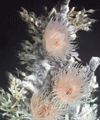January
Cold waters give up their hottest secret

A seven-armed sea-star and a new species of yeti crab have been found living on previously undiscovered hydrothermal vents at the bottom of the Southern Ocean.
These vents or “black smokers” are underwater hot springs where water heated by volcanic activity under the seabed gushes out of seabed chimneys at temperatures of up to 400oC.
Funded by the Natural Environment Research Council (NERC), the discovery was made by a leading team of scientists from institutions across the UK.
The findings represent a crucial step towards understanding the role played by these sites in sustaining unique deep-sea life and influencing our oceans’ chemistry.
The results, published today in the online journal PLoS Biology, are the result of three-years of exploration of the Antarctic vent ecosystems using the UK's ocean-going research ship, RRS James Cook.
Led by Oxford and Southampton Universities, the team included experts from the School of Marine Science and Technology at Newcastle University Professor Nicholas Polunin, Dr Christopher Sweeting and a PhD student William Reid.
Aiming to understand what these newly-discovered creatures eat and how food energy is transferred among species and into the surrounding sea, Dr Sweeting said this latest discovery suggests for the first time that life in these habitats around Antarctica is unique, having evolved to a large extent in isolation.
“We’ve had an inkling these vents exist ever since chemical signals were first detected in the water 15 years ago,” he explained.
“We were able to follow the trail of dissolved chemicals towards a source, much like tracking a chemical scent.
“Video footage was then used to confirm their existence - a challenge in itself. It was the equivalent of filming with a camera the size of a match box steered by a thread from 12 stories up.”
At a depth of 2400m or more where these vents were found, there is no sunlight. Animals associated with black smokers live on bacteria that use dissolved chemicals from hot water coming out of vents to produce their food. This sustains life and helps build the complex communities found.
These communities form islands of life on the ocean floor and may be 100s of metres to 100s of kilometres apart. Until now it was believed communities around Antarctica could be related to those in the Pacific, thanks to deep-water currents that run from west to east through the Drake Passage between Antarctica and South America.
Alternatively, the theory was that chemosynthetic communities around Antarctica could be related to the volcanic vents on the Mid-Atlantic Ridge via 'stepping stones' that existed in the geological past.
“What’s so exciting about this recent find is we have not only discovered some entirely new species but also other species which are found on vents elsewhere were absent,” said Dr Sweeting.
“This latest discovery suggests for the first time that life in these habitats around Antarctica is unique, having evolved to a large extent in isolation.
“Despite the harsh conditions these vents host a super abundance of animals. The yeti crab we found has never before been seen and yet here it was living in vast numbers piled one on top of another - up to 600 crabs per square metre. Smaller snails were found in concentrations of around 1000 per square metre.
“The next step now is to try to understand how vents support this mass of animals and how this potential food gets passed out into the wider ocean.”
A video of the "lost world" can be seen here.
published on: 4 January 2012
